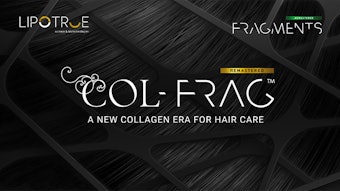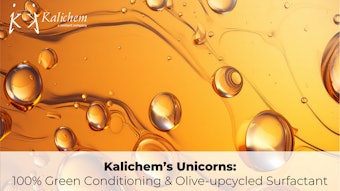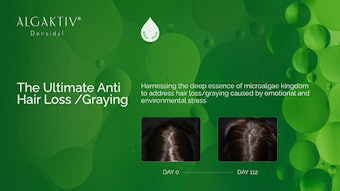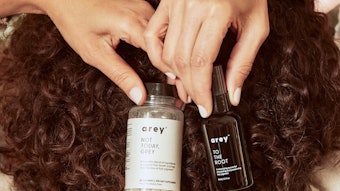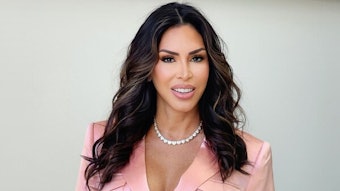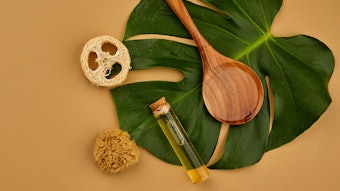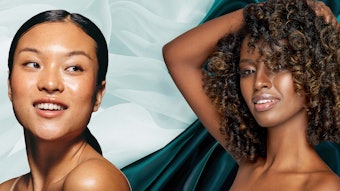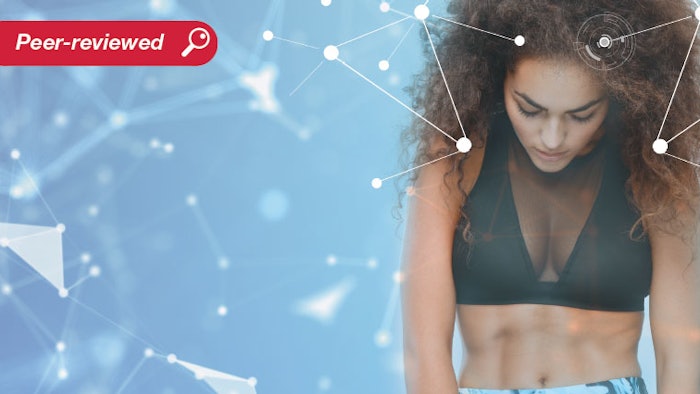
Bond builders are trending in hair care. So how do they work? This article explores the cross-linking bonds present in hair, how they are affected by damage and the ways in which cosmetic actives can alter them to improve hair properties. It also proposes paths forward in this engaging space.
Log in to view the full article
Bond builders are trending in hair care. So how do they work? This article explores the cross-linking bonds present in hair, how they are affected by damage and the ways in which cosmetic actives can alter them to improve hair properties. It also proposes paths forward in this engaging space.
Damage and breakage concerns remain high among hair product users, particularly those who are regularly using hair colorants, chemical treatments and heated styling tools, and with people frequently exposed to sunlight. Recently, a category of products has emerged claiming to be bond builders (see Figure 1). The language used is often bond-building but hair repair, restructuring and reconstruction are also used. A common feature of these products is that the actives are claimed to work from inside the hair to deliver strength or repair benefits.
The present article describes the different types of bonds present within hair, how these bonds are changed with insults such as coloring or sun exposure, and what published literature is available describing how added materials can rebuild these different bonds. It also outlines what data would be needed to investigate bond formation in hair and its consequent benefits.
The hair bond multiplier market size is expected to expand at a CAGR of 7.80% from 2021 to 2028."*
Bonds in Hair
Hair is composed largely of protein (65% to 95%)1 and contains three major structural components: the cortex, medulla and cuticle. The cortex provides the bulk of the hair mass and gives hair its tensile strength. In between the protein-rich cells in all three components is a lipid-rich cell membrane complex (CMC) that glues the cells together2 while simultaneously forming both a barrier against penetration and the major pathway of diffusion into the hair.3 The two most important types of protein structures in the hair cortex are the intermediate filaments and the matrix proteins.
Intermediate filaments: The intermediate filaments are made from keratins. Keratins are built from pairs of proteins tightly wrapped around each other in a highly ordered, alpha-helical conformation.4 These heterodimers are clustered into protofilaments, and protofilaments are bundled together to form the intermediate filaments.4 These give hair its tensile strength.5
Matrix proteins: Packed between the intermediate filaments are the matrix proteins, also known as keratin associated proteins. These proteins are more globular in structure6 and are highly cross-linked with one other and with the intermediate filaments.6 This creates a mesh-like structure that gives hair its flexibility.5
Protein molecules are assembled from linear chains of amino acids joined together with peptide bonds. However, further cross-linking bonds usually shape these proteins into the three-dimensional structures needed for them to function properly; for a review, see Reference 7.7 The different types of cross-linking bonds present in proteins are summarized in Figure 2.
Disulfide bonds: Disulfide bonds are the cross-links between pairs of cysteine residues on adjacent peptide chains. High levels of disulfide bonds are a unique feature of hair proteins. The matrix proteins contain higher levels of cysteine relative to intermediate filament proteins and are heavily cross-linked with disulfide bonds.6 Disulfide bonds also help matrix proteins attach to intermediate filament proteins,4 and the head groups of intermediate filament proteins to attach to each other.4
Ionic bonds: Ionic bonds form between ionized functional groups; for example, the basic side groups on arginine, histidine and lysine, and the acidic side groups on aspartic acid and glutamic acid. Ionic bonds, sometimes called salt linkages, help to construct tertiary and quaternary protein structures. These are relatively abundant in hair, with approximately 0.8 x 10-3 mol g-1 basic groups and 1.4 × 10-3 mol g-1 acidic groups being present in virgin fibers.1 This is roughly equivalent to the amount of cysteine able to create disulfide linkages (1.5 × 10-3 mol g-1).1
Hydrogen bonds: Hydrogen bonds form between atoms that have partial electrical charges; for example, between the δ+ hydrogen in a water molecule and the δ- oxygen in an adjacent water molecule. They also form between atoms on adjacent protein chains; such as between the δ+ amide hydrogen from a peptide with the δ- carbonyl oxygen of a neighboring peptide. Hydrogen bonds can also form between water molecules and proteins, and are important in the creation of secondary protein structures, such as α-helixes and β-sheets, and many other protein structures.
Hydrophobic interactions: Hydrophobic interactions are also important for building protein structures and cell membranes. In proteins, these interactions occur between non-polar amino acids, such as valine and proline, which tend to clump together to avoid interacting with water. These interactions are driven by thermodynamic effects and changes in hydrogen bonding in the surrounding water.
Hydrophobic interactions are additionally important in forming the lipid bilayers in the CMC. These lipid membranes are often a source of breakage, where cracks form and propagate along the membrane interfaces.8 Once hydrophobic groups come into close contact, through the exclusion of water, van der Waals bonds help hold them together.
The sensitivity of hair to factors such as moisture and pH means these variables need to be carefully controlled when testing bond builders."
Changing Bonds and Structures: Hair Damage
Chemical treatments, heat or sun exposure create permanent changes to covalent bonds in the hair. For example, coloring and bleaching will cleave disulfide bonds and create cysteic acid residues – a change that is irreversible. For a review of hair damage mechanisms, see Reference 9.9
Mass spectroscopy studies have explored all the chemical reactions occurring during bleaching treatments at a molecular level. The data confirms that disulfide bonds are the most susceptible to oxidative damage from bleach treatments and analyses show significantly raised levels of cysteic acid in bleached hair.10
Sometimes, changes to covalent cross-linking bonds are reversible. An example of such is in the perming process. Here, thioglycolate is used as a reducing agent to break disulfide bonds; the hair is reshaped, for example, into a curl; and hydrogen peroxide is used to reform a new disulfide bond.11 Breaking and reforming these types of bonds, however, is often damaging over time.
Hair damage will affect all types of cross-linking bonds, not just disulfide bonds. For example, the creation of cysteic acid residues with bleaching damage will encourage the formation of new ionic bonds with free basic groups and higher levels of cross-linking. This probably explains why bleach-damaged hair is stiffer – having a higher Young’s Modulus – than virgin hair (at < 60-70% relative humidity).12
Hair damage will also negatively affect the overall structure and ordering of hair proteins and CMC lipids. This is observed in differential scanning calorimetry studies, where hair damage through chemical treatments negatively affects the denaturation endotherm of cortical proteins;13 and in TEM studies, for example, on UV damaged hair, where the CMC lipids are missing or highly disordered.14
It is important to mention at this point that the level and type of damage created in hair will affect the scale of the effects observed with bond-building treatments. If the level of damage is too low, treatment effects will be difficult to measure versus the control. If the level of damage is too high, treatments might struggle to impart any effect. Preliminary experiments are often useful to get this right.
Effects of Water, pH and Metal Ions on Bonds
While hair might seem dead and therefore unable to respond to stimuli, it is actually very sensitive to the surrounding environment. For example, hair is sensitive to water. The adsorption of water molecules onto hair proteins leads to the breakage of interprotein hydrogen bonds, enabling the hair to swell and become more flexible.15 Consequently, water acts as a plasticizer to protein structures in hair, reducing its resistance to breakage.
Hair is much more fragile when it is wet. Blow-drying the hair to remove water restores interprotein hydrogen bonds and stiffens the hair, enabling it to be set into a particular style. In fact, one might argue that blow-drying is a good bond-building treatment.
Hair is also sensitive to the pH of applied treatments,16 which may come as no surprise when you remember that the ionic bonds in hair are formed between acidic amino acids such as glutamic or aspartic acid, and basic amino acids such as arginine or histidine. The charges on these amino acids are all quite sensitive to changes in the surrounding pH.
Sometimes formulators take advantage of the hair’s sensitivity to pH. High pH levels, for example, are often used in chemical treatments and colorants to neutralize basic amino acids, break ionic bonds and to encourage hair swelling and increased permeability to active ingredients.
Finally, hair is also sensitive to metal ions in tap water.17, 18 The creation of negatively charged groups such as carboxylates (COO-) or sulfonates (SO4-) during oxidative processes involved in coloring or UV exposure can create complexation sites for metal ions such as copper, calcium and magnesium. The ionic bonds formed between metal ions and the hair are reversible because they can be removed by lowering the hair’s pH (protonating the negatively charged amino acids) or by adding a chelant (replacing with sodium). Several research groups have shown that the uptake of metals such as calcium can change hair properties17 and reductions in Ca2+ have been linked to improvements in resistance to hair breakage and reductions in the elastic modulus.18
The sensitivity of hair to factors such as moisture and pH means these variables must be carefully controlled when designing experiments for bond-building treatments. For example, the effects of bond building on hair’s mechanical properties will vary greatly as a function of the humidity at which the measurements are taken. In addition, when testing the effects of any active, the treatment pH must be carefully controlled during dosing and the pH of the active-free control always matched with the treatment.
High molecular weight proteins applied to relaxer-damaged textured hair have been shown to reduce premature fractures and to increase break stress."
Defining Bond Builders
There is not yet an agreed upon scientific definition of a bond builder for hair. The present authors propose the following definition: “a formulation component that is able to penetrate into the hair and improve or restore the internal structure of hair, giving rise to an improvement in hair mechanical properties.”
There are a few important inclusions and emissions from this definition. Use of the term formulation component allows for both single molecules or blends of ingredients to be considered bond builders. It also does not restrict the definition to any particular type of molecule.
Use of the word penetrate implies that these actives work inside hair and do not produce their effects through a surface action. Improvement and restoration of internal structure means the term is not restricted to treatments for damaged hair. It also does not restrict treatments to the restoration or repair of any particular bond type. Any treatment that interacts with and improves internal hair structures can be a bond builder.
Finally, the requirement for improvement of mechanical properties means the bond builder must have a measurable effect. There is an important difference between perceptible and measurable, and the proposed definition does not require treatments to create consumer-perceived effects.
Bond Builders in the Literature
The amount of high-quality information about bond builders in the scientific literature is limited, and most studies have not yet been successfully reproduced by multiple investigators. The key articles available in peer-reviewed journals are reviewed here but clearly, there is much more work to be done to understand how bond builders interact with the hair.
Organic acids and related actives: The most widely investigated bond builders in hair care at present are the organic acids (see Figure 3). Research has shown that treating hair with malic acid can reduce the water content of the hair.19 In this work, the investigators proposed that the carboxyl groups on the acid are able to bind, through ionic bonds, to free basic groups in the hair proteins and reduce water binding. Reduced water content was shown to improve hair set durability and style hold.19 It also closed the voids inside chemically damaged hair, improving light transmission through the hair and the color vibrancy of hair shine.20
Dynamic vapor sorption studies (see Figure 4) have confirmed that a wide range of mono-, di- and trivalent organic acids can reduce water uptake into the hair.21 Hair swelling studies have also shown that lactic acid, in combination with Ca2+ at a pH of 4.5, can reduce the swelling in bleach damaged hair and, as a result, reduce hair color fade from semi-permanent dyes.22
It is interesting to note that the bis-aminopropyl diglycol dimaleate, a well-known hair care treatment,23 includes maleic acid, a divalent organic acid, as part of its structure.
Other small molecules have been investigated as hair repair agents, such as hydroxypropyl gluconamide, which has been shown, through DSC and spectroscopy studies, to improve protein integrity in damaged hair and to reduce hair breakage.24 Glycine-betaine, an osmoprotectant extracted from sugar beet molasses, has demonstrated the ability to penetrate the hair and to affect hair mechanical properties.25
Finally, divalent organic acids, such as maleic acid and succinic acid, have also been used to prevent hair damage from bleach and coloring treatments.26 The mechanisms by which these work are still unclear but extra cross-linking of proteins, preventing access to peroxide, is one hypothesis; the chelation of metal ions (catalysts for oxidative damage) by the organic acids could be an alternative.
Proteins and peptides: Proteins and peptides have been well-studied as functional ingredients for hair products; for a recent review, see Reference 27.27 Fluorescence microscopy has shown these materials can penetrate hair depending on their molecular weight (see Figure 5).28, 29 Notably, penetration is also better in damaged hair where the cell membrane complex is more permeable.29
Keratin associated proteins are highly cross-linked with one other and with intermediate filaments. This creates a mesh-like structure that gives hair its flexibility."
Low molecular weight proteins and peptides not only penetrate hair, but also affect water absorption.30 They additionally have been shown to induce changes to tensile properties, including a reduction in stress relaxation as the hair dries.31 It is possible that these proteins are penetrating into the matrix proteins of hair and, once there, affecting various interprotein bonds. Protein bonding assays have been used to optimize protein synthesis and maximize these interactions, and “bespoke” proteins have been shown to deliver strengthening and straightening effects.32, 33
Higher molecular weight proteins are less able to penetrate even damaged hair and are delivered mostly to the hair surface. However, high molecular weight proteins applied to relaxer damaged textured hair have been shown to reduce premature fractures and to increase break stress.29 Here, it is possible that large proteins have bulk adhesive effects and are able to seal cracks in the hair surface, reducing breakage.
Lipids: Organic acids and proteins will typically penetrate into protein regions of hair and interact via ionic and hydrogen bonds with hair proteins. The partitioning into the protein regions is driven by these strong interactions.
For lipids such as fatty acids and fatty alcohols, the strongest interaction is via hydrophobic interactions with lipids found in the medulla in the CMC. Penetration of these materials has been quantified by extraction methods34 and visualized by Nano-SIMS using 2D-labeled C16, C18 fatty acids and alcohols (see Figure 6).35 This research showed hydrophilic materials (log P < 2) partitioned into the protein regions and hydrophobic materials (log P >5) partitioned into the lipid regions. Evidence of strong hydrophobic interactions with fatty alcohols penetrated into hair were demonstrated by an increase in fatigue strength.36
Conclusion
The past 10 years have seen an exponential increase in the use of bond-building treatments and claims in hair care. While previously undefined, bond builders are defined here as the following: “a formulation component that is able to penetrate into the hair to improve or restore the internal structure of hair, giving rise to an improvement in hair mechanical properties.” Bond builders, according to this definition, include a broad range of actives including organic acids, proteins and lipids.
This review has shown that various cross-linking bonds in the hair are responsible for hair’s structure and properties. These bonds, particularly disulfide bonds, are affected by hair damage. Furthermore, many of these bonds are quite sensitive to environmental factors, e.g., pH, water content and metal ions. Therefore, experiments designed to test bond-building actives must take all of these factors into account to avoid misleading results.
Looking ahead, further research on the effects of bond builders should focus on three key areas: 1) actives penetration, 2) improvement or restoration of internal hair structures and 3) improvement in mechanical properties. Actives penetration could be investigated using autoradiography, fluorescence microscopy, FTIR or Raman microscopy, ToF SIMS and nano SIMS. Effects on protein structures could be captured using differential scanning calorimetry, FTIR or Raman spectroscopy, NMR and dynamic vapor sorption. Finally, improvements to mechanical properties could be investigated using single fiber tensile studies and single fiber fatigue studies. Clearly, there is much more to be learned in this fascinating area of hair science.
References
- Robbins, C.R. (2012) Chemical composition of different hair types. In: Robbins, C.R., Chemical and Physical Behavior of Human Hair, 5th edn. Berlin & Heidelberg, Germany. Springer-Verlag pp 105-176.
- Robbins, C.R. (2009) The cell membrane complex: Three related but different cellular cohesion components of mammalian hair fibers. J Cosmet Sci. 60(4) 437-465.
- Gummer, C.L. (2001) Elucidating penetration pathways into the hair fiber using novel microscopic techniques. J Cosmet Sci. 52(5) 265-280.
- Fraser, R.D.B. and Parry, D.A.D. (2018) Structural hierarchy of trichocyte keratin intermediate filaments. In: Plowman, J.E., Harland, D.P. and Deb-Choudhury, S., eds, The Hair Fiber: Proteins, Structure and Development. Berlin & Heidelberg, Germany. Springer-Verlag pp 57-70.
- Feughelman, M. (1959) A two-phase structure for keratin fibers. Textile Res J. 29(3) 223-228.
- Fraser, R.D.B. and Parry, D.A.D. (2018) Trichocyte keratin-associated proteins. In: Plowman, J.E., Harland, D.P. and Deb-Choudhury, S., eds, The Hair Fiber: Proteins, Structure and Development. Berlin & Heidelberg, Germany. Springer-Verlag pp 71-86.
- Campbell, N.A, Reece, J.B., ... Jackson, R.B., et al. (2015) Biology: A Global Approach, 10th edn. Harlow, UK. Pearson Education Ltd. pp 130-131.
- Camacho-Bragado, G.A., Balooch, G., Dixon-Parks, F., Porter, C. and Bryant, H. (2015) Understanding breakage in curly hair. Brit J Dermatol. 173(suppl. 2) pp 10-16.
- Popescu, C. (2012) Hair damage. In: Evans, T. and Wickett, R.R., eds, Practical Modern Hair Science. Carol Stream, IL USA. Allured Business Media pp 367-388.
- Dyer, J.M., Bell, F., ... Harland, D.P., et al. (2013) Redox proteomic evaluation of bleaching and alkali damage in human hair. Int J Cosmet Sci. 35(6) 555-61.
- Evans, T. (2021) A review of permanent waving and perm chemistry. J Cosmet Sci. 72(1) 1-35.
- Evans, T.A. (2017) How damaged is hair? Part II, internal damage. Cosm & Toil. 132(6) 36-45.
- Wortmann, F.-J., Springob, C. and Sendelbach, G. (2002) Investigations of cosmetically treated human hair by differential scanning calorimetry in water. J Cosmet Sci. 53 219-28.
- Richena, M. and Rezende, C.A. (2016) Morphological degradation of human hair cuticle due to simulated sunlight irradiation and washing. J Photochemi Photobiol B: Biology. 161(supplement C) 430-440.
- Breakspear, S., Frueh, P., Neu, A., Noecker, B., Popescu, C. and Uellner, Q. (2022) Learning from hair moisture sorption and hysteresis. Int J Cosmet Sci. 44 555-568.
- Malinauskyte, E., Cornwell, P.A., Reay, L., Shaw, N. and Petkov, J. (2020) Effect of equilibrium pH on the structure and properties of bleach-damaged human hair fibers. Biopolymers. 111(11) e23401.
- Evans, A. (2011) Investigation of the interaction between water hardness metals and human hair. Available at https://bit.ly/3wQwHpj
- Kaeser, A., Chaumontet, M., ... Baghdadli, N., et al. (2022) How to alleviate the impact of calcium on hair mechanical properties? A new specific combination of acids for hair care. Poster 355, 32nd IFSCC Congress, London.
- Itou, T., Nojiri, M., Ootsuka, Y., Nakamura, K. (2006) Study of the interaction between hair protein and organic acid that improves hair-set durability by near-infrared spectroscopy. J Cosmet Sci. 57(2) 139-51.
- Okamoto, M., Yakawa, R., ... Satoh, N., et al. (2003) Influence of internal structures of hair fiber on hair appearance. III. Generation of light-scattering factors in hair cuticles and the influence on hair shine. J Cosmet Sci. 54(4) 353-66.
- Evans, T.A (2018) Your hair on acid: The influence of carboxylic acids. Cosm & Toil. 133(9) 40-48.
- Schulze Zur Wiesche, E., Krohn, R., Freye, S. and Wortmann, F-J. (2015) Changing the absorption and desorption properties of human hair by ion-induced matrix modification. HairS’15 Conference, Trier, Germany.
- Pressly, E.D. and Hawker, C.J. (2015) Method for fixing hair and skin. US Patent US2015/0043117 A1.
- Everaert, E.P.J.M., Tran, D., ... McMullen, R.L., et al. (2016) Strengthening the hair fiber from within: Repairing the cortex of damaged hair. IFSCC Magazine. 3 111-117.
- Gummer, C.L., C. Gherardi and Pericu, P. (2017) Glycine-betaine working at the core of the hair fiber. SOFW. 143(11) 8-10.
- Förster, T., Hippe, T. and Knübel, G. (2018) Is repair of lightened hair feasible? Myths and facts on different hair bonding treatments. SOFW. 144(3) 2-9.
- Tinoco, A., Martins, M., Cavaco-Paulo, A. and Ribeiro, A. (2021) Biotechnology of functional proteins and peptides for hair cosmetic formulations. Trends in Biotechnology. 40(5) 591-605.
- Swift, J.A., Chahal, S.P., Challoner, N.I. and Parfrey, J.E. (2000). Investigations on the penetration of hydrolyzed wheat proteins into human hair by confocal laser-scanning fluorescence microscopy. J Cosmet Sci. 51(3) 193-203.
- Malinauskyte, E., Shrestha, R., Cornwell, P.A., Gourion-Arsiquaud, S. and Hindley, M. (2021) Penetration of different molecular weight hydrolyzed keratins into hair fibers and their effects on the physical properties of textured hair. Int J Cosmet Sci. 43(1) 26-37.
- Barba, C., Marti, M., ... Coderch, L., et al. (2010). Effect of wool keratin proteins and peptides on hair water sorption kinetics. J Therm Anal. 102 43-48.
- Gamez-Garcia, M. (1993). Effects of some oils, emulsions and other aqueous systems on the mechanical properties of hair at small deformations. J Cosmet Sci. 44, 69-87.
- Cruz, C.F., Azoia, N.G., Matama, T. and Cavaco-Paulo, A. (2017) Peptide-protein interactions within human hair keratins. Int J Biol Macromol. 101 805-814.
- Cruz, C.F., Martins, M., Egipto, J., Osorio, H., Ribeiro, A. and Cavaco-Paulo, A. (2017) Changing the shape of hair with keratin peptides. RSC Advances. 7 51581-51592.
- Marsh, J.M., Whitaker, S., ... Hawkins, T.J., et al. (2018) Role of internal lipids in hair health. J Cosmet Sci. 69 1-10.
- Marsh, J.M., Song, H., ... Jiang, H., et al. (2019). High-resolution visualization of cosmetic active compounds in hair using nanoscale secondary ion mass spectrometry. Colloid Surface B. 174, 563-568.
- Marsh, J.M., Brown, M.A., ... Henry, I.D., et al. (2017) Gel network shampoo formulation and hair health benefits. Intl J Cos Sci. 39(5) 543-549.
*Source: Data Bridge Market Research
